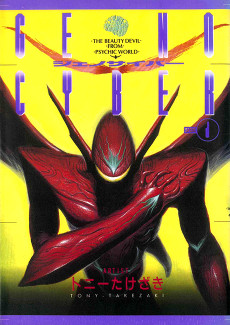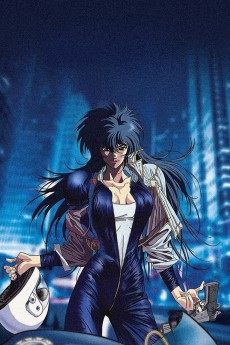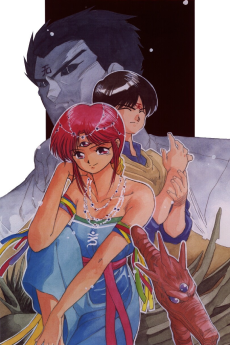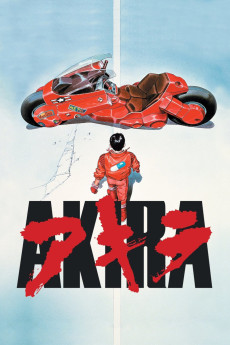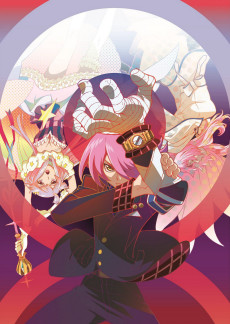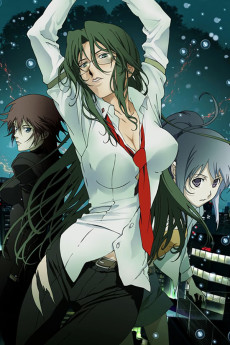GENOCYBER
STATUS
COMPLETE
EPISODES
5
RELEASE
July 21, 1994
LENGTH
29 min
DESCRIPTION
As the nations of the world begin to merge, world peace is threatened by the private armies of individual corporations. The Kuryu Group has just discovered a weapon that will tip world power in their favor. The Genocyber: a nightmarish combination of cybernetics and psychic potential. Many desire to control this monstrosity, but can its hatred be contained... Battle erupts, and the cyberpunk world of the future is about to explode with violence.
(Source: Anime News Network)
CAST

Elaine Reed
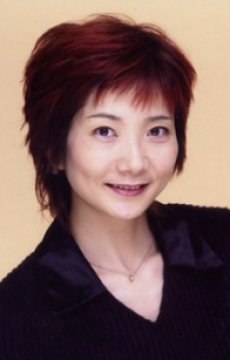
Akiko Hiramatsu
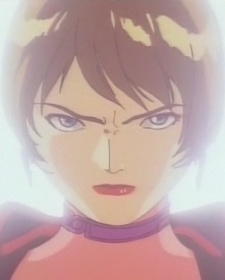
Diana Reed

Akiko Hiramatsu
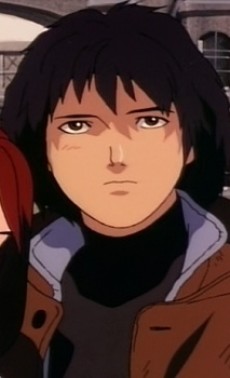
Ryu
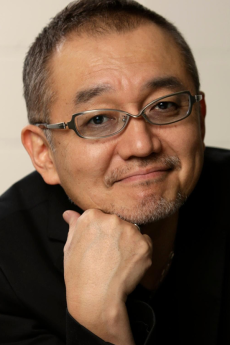
Kouji Tsujitani
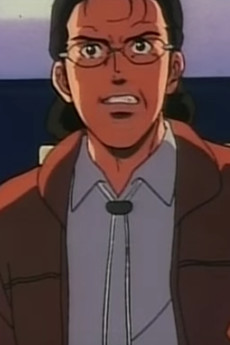
Sakomizu
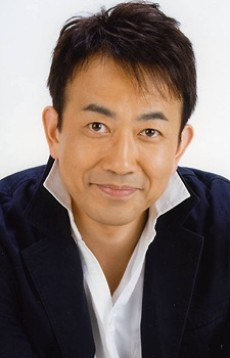
Toshihiko Seki

Mel

Kumiko Nishihara
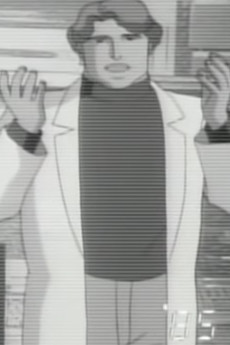
Nguyen Morgan
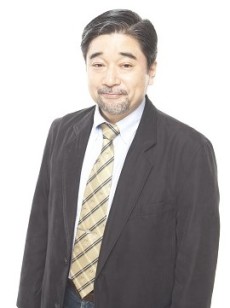
Mitsuaki Hoshino
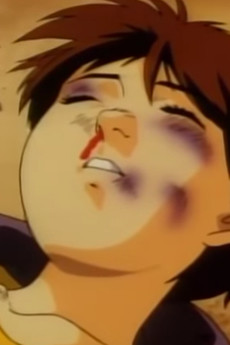
Rat

Kaoru Shimamura
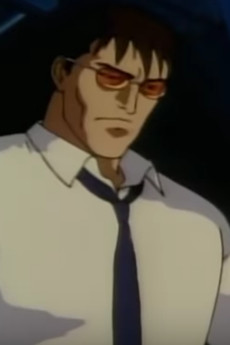
Davey
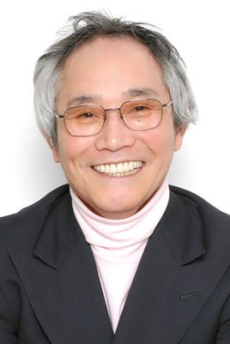
Rokuro Naya
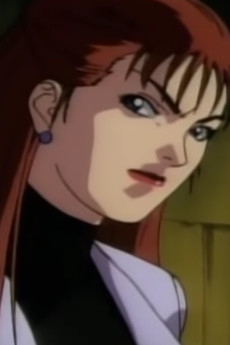
Amachi

Emi Shinohara
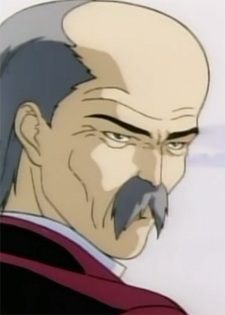
Kenneth Reed
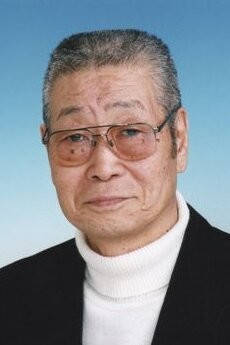
Seizou Katou
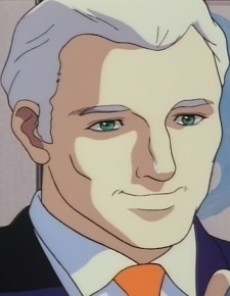
Grimson Rockwell
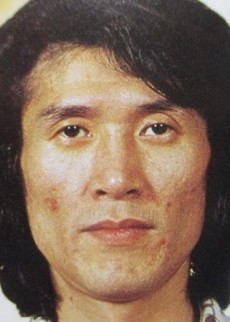
Kazuyuki Sogabe
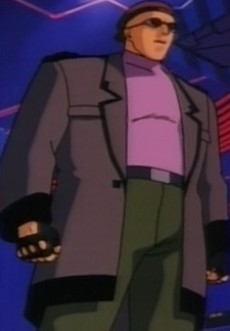
Wakayama
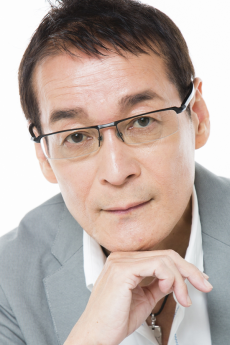
Norio Wakamoto
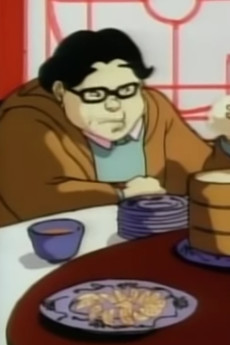
Katsu
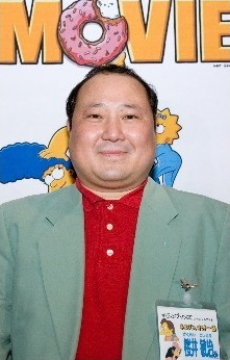
Toshiharu Sakurai
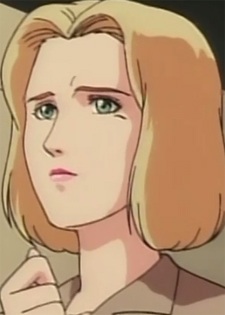
Myra
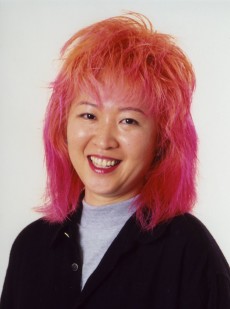
Masako Katsuki
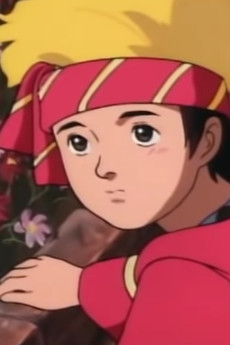
Roko

Shinobu Adachi
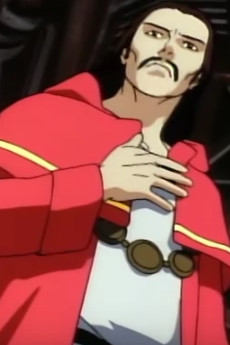
Guru
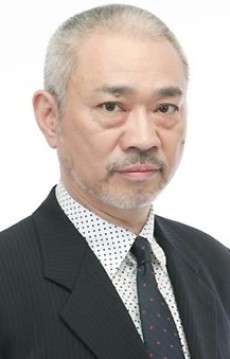
Ryuuzaburou Ootomo
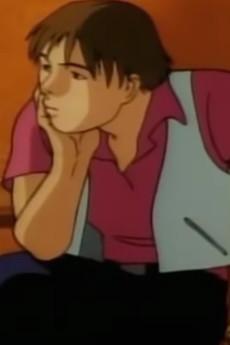
Sly
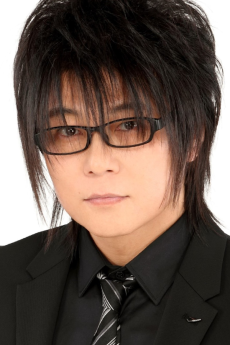
Toshiyuki Morikawa
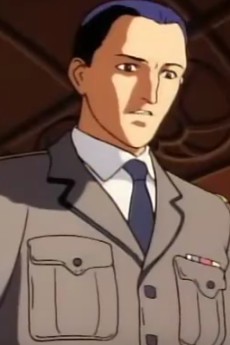
Captain Radneck
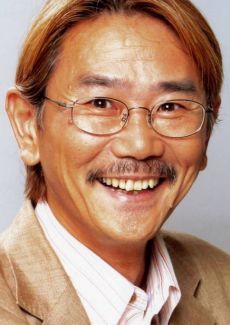
Shigeru Chiba
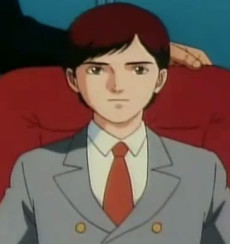
Genichiro Kuryu
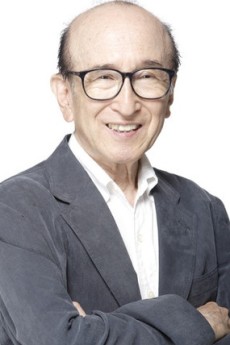
Tamio Ooki
EPISODES
Dubbed
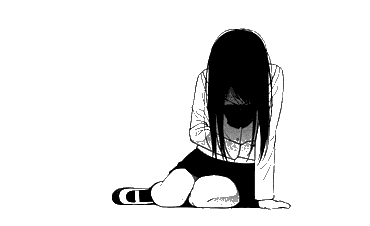
Not available on crunchyroll
RELATED TO GENOCYBER
REVIEWS

GhostHardware
60/100A confusing story and over the top gore overshadows some creative ideasContinue on AniListNotorious for its over the top gore, the Cyperpunk-themed Genocyber is let down by some poor creative decisions, but redeems itself by the end.
Made up of five episodes, the first is the 45-minute-long ‘A New Life’ which follows the common format of a lawless dystopia ruled by large corporations, with amoral characters and a heavy helping of over the top violence to boot. The storyline follows two psychic sisters Elaine (who has the mind of an animal) and Diana (who is missing limbs), both possess strong ESP like powers. A huge corporation known as the ‘Kuryu Group’ is attempting to fuse the two sisters together, to create the ‘Genocyber’ which is a humanoid creature with overwhelming destructive power.Well... at least that’s what I was able to piece together from what I watched. The problem is that the pace is so fast that the story can’t catch up. I had a very vague idea of what was going on and I was left confused about the characters actions, major plot points etc. There was no breathing room whatsoever, it felt like there was gaps in the story that were filled in quite poorly by extended action scenes. I was left scratching my head at the end of this one.
The episode uses a mix of live action, real-life photographs and pencil drawings. It’s an interesting combination, and it works very well. I don’t know if it was done for budget or creative reasons but in any case it was a great choice. Easily one of the highlights of the first episode. I attempted to watch this at first using the English dub, but as is usually the case with niche OVA’s from this period it was horrible. Bad voice acting, constant F bombs… the usual. The Japanese dub is perfectly fine, I don’t understand the concept of watching a bad dub for the ‘comedy’ factor when the show itself is trying to be serious. The music ranged from good to great, with some memorable themes occurring in the big battles. The sound designers made smart use of the soundstage too, some really solid and effective sound effects throughout; their effort really shines.
The second episode takes a different approach and is set in a smaller location with a few core characters. Thankfully, the pace has slowed down and it also brings in a more low-key horror element. It also begins with one of the most sickening sequences I've seen in an anime: kids being shot in incredibly graphic detail. This episode was surprisingly short however, clocking in at under 20 minutes but it was a step in the right direction in some ways. The creative art present in the first episode however is nowhere to be seen. Episode three follows straight on from the ending of the episode two and starts ok, but unfortunately crashes and burns by the end. The pacing very quickly becomes erratic and the new characters are all squandered for the sake of showing more graphic violence and action scenes. A very disappointing end to this one.
The last two episodes are completely different. Here, we learn that the world has mostly been destroyed by the Genocyber and the small society that remains is now under police state control. We follow two brand new characters (Mel and Ryu) who attempt to raise money to pay for Mel’s eye operation as she is blind. Mel also possesses ESP/Telekinesis powers, which eventually leads to a religious cult group recruiting her as their new leader. The Genocyber is revered by them as a kind of ‘God’ who caused destruction of the earth to begin life anew with the followers as the ‘seeds’ of its creation. The atmosphere is changed completely in this arc, its more grounded and almost feels like a completely different show. There’s far less graphic violence, sympathetic lead characters who are given decent backstory and even a shockingly tasteful love scene; all of this is barely comparable to the more unbelievable storyline elements and content of the first 3 episodes. The world design is also influenced more by Steampunk versus the Cyberpunk setting of the first arc.
Now I can understand the complaints folks have had about the change in tone, as this is a far cry from the previous over the top B-movie chaos and destruction. Personally, I thought this was an interesting creative decision and my main complaint here is that there weren’t more episodes to flesh it out. Look, it wasn’t anything amazing and plenty of flaws are still present, but I was more invested here and it’s a shame it all wrapped up so quickly. I can’t give Genocyber much praise as a whole due to the abundant problems it contains but its still decent entertainment, and the last arc is unfairly maligned.

ohohohohohoho
75/100Cybernetic anti-capitalist revenge pornContinue on AniListGenocyber is old, and it's grindhouse gory. You're probably watching it in 480p. When I sit down to watch it on my laptop, I feel like I'm watching a video I rented from Blockbuster; although now that I think of it, when I was a kid, we rented from a store called Family Video. It was around the corner from my house, owned and run by a Chinese family. It closed down over a decade ago. As far as I can tell, this store had no affiliation with the chain of video stores with the same name that recently closed all of their physical locations. The Family Video on the corner of Beach Street has long been swallowed up by time. Without some foresight, some money, and some luck, no one can anticipate and keep up with progress. Humanity's technological advancement, a quest that has no end and offers profit without end, is the focus, and humanity itself is in the periphery. Grab onto whatever hunk of metal is drifting nearby and hope it keeps you afloat while the chemical contaminated water rises. Destroying ourselves means nothing if we learn how to make new, better selves in the process.
Perhaps this melancholic, grainy nostalgia which watching a "dated" anime like Genocyber conjures has only added to the experience of watching it, like it's only 30 years later, after sitting around in a state of neglect that the anime is really finished. Hopefully it'll never be a candidate for digital restoration.
Genocyber is anti-capitalist revenge porn. It is actually thematically quite similar to Patlabor 2, but whereas Patlabor 2 is quiet and refined, with a staid, thoughtful, melancholic beauty, Genocyber is furious and vital, and kind of a piece of shit sometimes.
It is a story in three parts, a triptych of anguish and violence. The middle story is the weakest, a somewhat typical anti-war diatribe with a big monster. The last story, which is clearly intended to be the redemptive arc, where we're shown a path forward, feels a little truncated, ultimately not tying together too neatly after an admirable start. Much of the visual experimentation peters out after the first, extended episode, which suggests that time and money constraints impacted the latter parts of production. It was, of course, cancelled after episode 5.
Part one introduces us into a world not too much unlike our own (other than the psychic powers and advanced, weaponized prosthetics, but who knows what the future holds 10 or 20 years from now), except that we are unable to avert our eyes from the violence at the heart of progress. Creative energy is converted into destructive energy. There's an obsession with "upgrading," maximizing the potential of the brain through scientific intervention, destroying and replacing the flesh with machine. Once one person becomes upgraded, that becomes the standard to which everyone else has to rise, or else become ripped apart by time's march forward.
Transhumanism is compulsory. You HAVE to upgrade if you want to keep living, to be seen as productive, whether you're happy about it or not. It's like trying to live without a smart phone, except the cybernetic upgrades in Genocyber are not only contained in artifacts we carry around, they must be applied to our own bodies. Is it really so different, though? Everyone is in a constant state hyper-competition, both to invent the new human, and to avoid obsolescence.
This hubristic desire to shatter the limitations of the human body goes awry when it comes into contact with the equally delimited empathic, spiritual dimension of Elaine's consciousness. Her mind's potential is unlocked, but she is still a child, with an "animalistic" nature. She's innocent, uncorrupted by the perverse impulses of capitalism and progress which place their own goals over the wellbeing of individuals and communities. She values life, and feels for people, which are the natural impulses of human consciousness.
The opposition between the spiritual, naïve, empathic human and the selfish, power-hungry, "progressive" technocapitalist is set up in the first episode, and is returned to in episodes 4 and 5. The "progressive" aspires toward God-like power, and the empath is inherently more God-like because she retains the capacity to love. This capacity is seen as endemic to the enlightened mind in Buddhist traditions, and it's no coincidence that Elaine's conscious potential, her "Vajra," is unlocked via the use of a technological "Mandala." The Kuryu group hoped to create an unparalleled weapon, which they termed a Vajra to symbolize the ascent of humanity to god-like status, but what they created was a weapon that, like the actual Vajra of myth, was turned against the sinners and the ignorant, the enemies of love; in other words, adherents of this unforgiving, inhumane system of capital, progress, and destruction such as the Kuryu group itself.
In episodes 4 and 5, the focus becomes sight as a metaphor. Blindness is another form of naivety, but it is one that is counterintuitively liberating. Mel is incapable of seeing the physical world, which allows her to see things others can't. She has insight, and empathy, and comes to be fetishized as a prophet by desperate cultists. Blindness is also a source of levity. It provides Mel with the space to resist "the Spectacle," the illusory world of the capitalist monolith Grand Ark city, wherein happiness is something bought and sold. Meanwhile people who have no money either suffer or kill one another to attain it. Misery is hidden away, poverty is an indication of personal weakness and depravity, of failure. Mel cannot see the illusion, so she isn't distracted by it, while Ryu cannot help but be tempted. He voluntarily, temporarily blinds himself when he commits his selfish act of violence for money. The city of the Grand Ark is like Tokyo in Patlabor 2, or Macross Fortress in Macross Plus. Many of the promises of capitalism and technological progress aren't real, but their costs to human life are. However, all we focus on is the illusion, the promise. The story ends suddenly with the destruction of the Ark, hopefully destroying the illusion and giving humanity a chance to start over from a state of innocence.
While a little roughshod and uneven in its presentation, I think the story of Genocyber is actually far more intelligent than it's given credit for. The hyper violent veneer is a distraction for some viewers, or even all that some viewers seem to see, but for me, it is essential for representing the diffuse violence of the systems Genocyber is criticizing. This critical narrative is both vital and at times, gripping. If you think you've got the stomach for it, give it a chance.

Kuma187
38/100A raging mix of interesting thematics and bad storytelling put through a blender of gore and hatred (spoilers)Continue on AniListNeither their silver nor their gold shall be able to deliver them on the day of the wrath of the Lord. In the fire of his jealousy, all the earth shall be consumed; for a full and sudden end he will make of all the inhabitants of the earth.
Zephaniah 1:18
Note: I have decided to exclude graphic content from this review's visuals
If you ask your average young anime watcher about gore animated works, that person will probably come up with what came to be known as the representatives of the concept: Higurashi no Naku Koro Ni, Devilman Crybaby, Hellsing Ultimate... Should you be unlucky and ask a person with questionable tastes, this one could even recommend you Elfen Lied, Blood C, or Tokyo Ghoul. However, a more seasoned anime veteran will probably take you a bit further back, to the land of the 90s or even 80s, the territories of old, « cult classics » that most people nowadays tend to shun. Within this particular timeframe, one ultraviolent anime in particular stands out among the rest: that is Genocyber.
Genocyber takes place in a grimdark, cyberpunkish version of our world where wars led by conglomerates tear the world apart and lead to the suffering of the people. There, we follow Elaine, a feral, powerful esper girl, and her interactions with a merciless world of death, suffering, and despair. Throughout the story, and after merging with her sister, Diana Reed, she takes on the form of the Genocyber, an incredibly powerful cybernetic monster wielding psychic and psychokinetic abilities who destroys anything it encounters. The story is told in 3 distinct arcs: the first episode is the beginnings, the origin of the monster. Episode 2 and 3 show Elaine's growth and how the final conflict started for humanity, while episode 4 and 5 are centered around a young couple arriving in a city with an oppressive government that constitutes some of the remnants of the human world long after said war ended.
Let's just put this one out of the way: like I've said before, Genocyber is incredibly violent and gore. In fact, episode 1 and 2 are usually used by fans of older anime as an example of how old school body horror used to be done: taking into consideration the fact that the artstyle is not only quite realistic and very well shaded, the images of bodies being ripped apart, guts spilling everywhere, beheadings, flesh torn asunder by gunfire and highly cybernetically augmented bodies look certainly more gruesome, or at least convincing, than anything Blood-C could come up with. Such are the visuals that have marked the minds of a certain number of those people who watched low image quality, imported anime OVAs back in the 90s.
The problem is that this ultraviolence is beyond gratuitous, and it becomes clear within the first few minutes of the carnage happening in the hospital that this is (mostly) being shown this way to please a certain crowd, and all the time and effort spent drawing and animating this first episode should have probably been spent on actually creating a coherent, less technobabble-filled story. Indeed, episode 1, serving as the origin story of a monster created through inhumane levels of scientific and cybernetic manipulation, is filled with exposition, pseudo-scientific droning and mindless violence, to the point where most people looking for an intriguing story will just start “switching their brains off”, if not lose interest altogether, which is a shame since the last arc of the anime effectively toned down the gore violence to the bare minimum and actually decided to focus on offering some proper storytelling with a lovely couple as protagonists.
However, this may have been an intended effect by the makers, as Genocyber's story is more of a metaphorical one than something you have to take at face value: in a very Lovecraftian and Shelleyian sense, the story represents science as an invading force, something that can be used for monstrous purposes, be it the dehumanization of people who augment themselves to the point where you can't even call them “people” anymore, but also the simple use of a helicopter to gun down innocents. And that's also not taking into account the second arc's boat crew who got instrumentalized and the female doctor who lost all sanity after going through the hell that resulted from such a horrible experiment.
The show's criticism also takes on corporatocracy, as it shows clearly that big corporations are exploitative in essence and evil in nature, as their dominance on the planetary level is the very reason the story happens altogether. That is why, when the Genocyber reaches the Kuryu Group's satellite at the end, it finds the place a deserted, empty ruin from which a broadcast kept running for many years: the Kuryu Group was long gone, but the threatening shadow of this once almighty force still remained. And it's only with the destruction of this last vestige of exploitation and terror that Elaina and Diana are finally free from the past and will be reborn.Speaking of rebirth, Genocyber also runs counter to a very frequent trope in modern media: where contemporary nihilistic, science-obsessed writers tend to use religion as a symbol of fanaticism, zealotry and ignorance to give more value to rational thinking and explanation, this anime does just the opposite and shows religious communautarism in a positive manner, where people can be themselves, connect with others on a deeper level, and be free from worldly desires, which are represented as sinful and the root of evil. Greed is the source of violence, and violence is the source of cybernetic augmentation, and all of that led to the events of the show. It's an unusual take on religion, martyrdom and “primal-ness” in media that deserves to be outlined, but I think it does so in a very one-sided way: science isn't nearly as bad as the anime tries to portray it, and religions aren't exactly exempt from flaws altogether.
And I can't say even some of those themes hold well at all: after all, Elaina might become the Genocyber to enact vengeance for the innocents who die at the hands of evil scientists, soldiers and corporations but she isn't exactly a paragon of virtue either, especially considering she's responsible for turning Hong Kong into an inferno before vaporizing what was left of it in her grief-filled rage, killing millions because her friend died and gave her one last farewell. Or triggering the last war against humanity after the boat incident. Which is my main criticism: Genocyber is childish. That may be ironic, given the amount of adult content, but while there are certainly some ideas, the tone is definitely reactionary, full of hatred, like the outburst of a kid trying to get back at the world for feeling that something is wrong and preaching for a return to a more “primal form of society”. The show later portrays the Genocyber as a godlike entity by the religious cult because it delivered humanity from what it had become, but I'm pretty certain a lot more innocents died in the global war when compared to the amount of “evildoers”.
I can't exactly praise the narrative story itself either. I've already touched upon the first episode earlier but the second arc is, ultimately, very vacuous and merely pitting two entities against each other because one hates the other simply for existing, which in turns triggers the ultimate war. Out of 5 episodes, 3 of them are simply incredibly messy because the framing of the events/explanations is very bad, to the point where it's often hard to understand exactly what's going on on screen the first time around, and it takes episode 4 to introduce some proper worldbuilding and actually likeable leads. I'd lie if I said I actually enjoyed myself watching Genocyber early on and in fact, it actually took me several years to complete this, because no episode other than episode 4 made me want to watch the next one. Also on a side note, I found it a bit hypocritical that Diana, who initially killed Elaina out of jealousy and anger, somehow decided to become the voice of reason to Elaina's remnants of primal anger in the last arc of redemption, but I guess so much time had passed that the past no longer actually matters.
All in all, Genocyber is a mess of anger and hatred that buries its metaphorical journey under a thick layer of obfuscation. The thematics might be interesting enough for me to try to decode them through the essay you've (hopefully) just read above, but the tone and the language used just aren't tasteful for most of the runtime to justify watching this unless you need your fix of bloody violence.
SIMILAR ANIMES YOU MAY LIKE
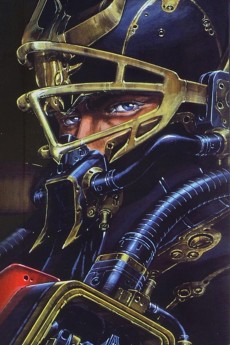 OVA ActionSoukihei MD Geist
OVA ActionSoukihei MD Geist OVA MechaSeijuuki Cyguard
OVA MechaSeijuuki Cyguard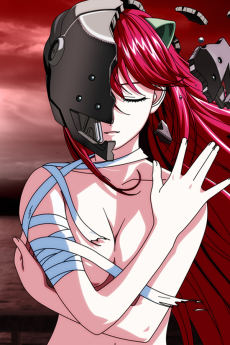 ANIME ActionElfen Lied
ANIME ActionElfen Lied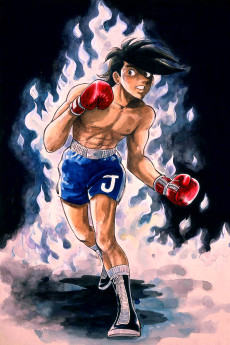 ANIME ActionAshita no Joe 2
ANIME ActionAshita no Joe 2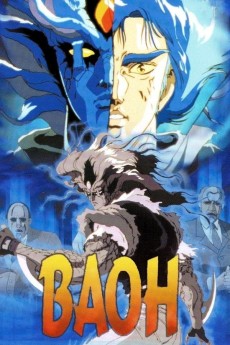 OVA ActionBaoh Raihousha
OVA ActionBaoh Raihousha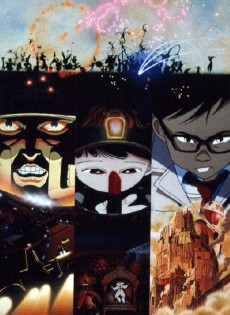 MOVIE AdventureMeikyuu Monogatari
MOVIE AdventureMeikyuu Monogatari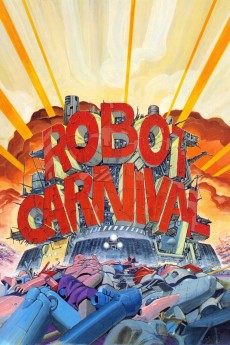 OVA ActionRobot Carnival
OVA ActionRobot Carnival
SCORE
- (2.65/5)
MORE INFO
Ended inJuly 21, 1994
Main Studio Artmic
Favorited by 94 Users


